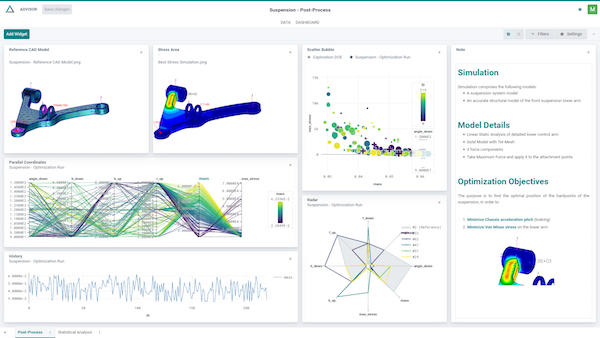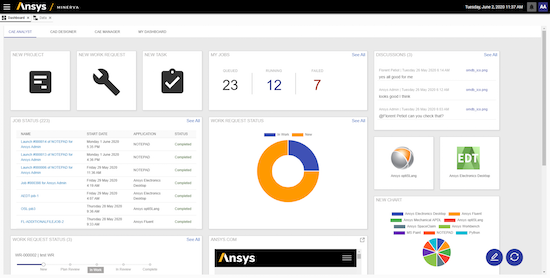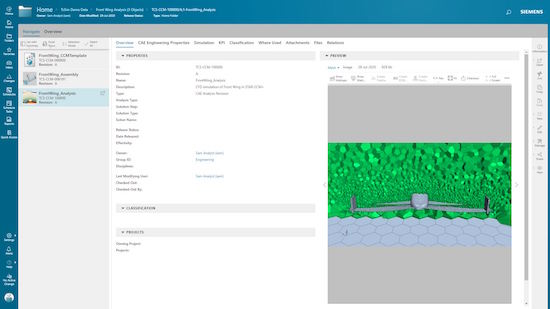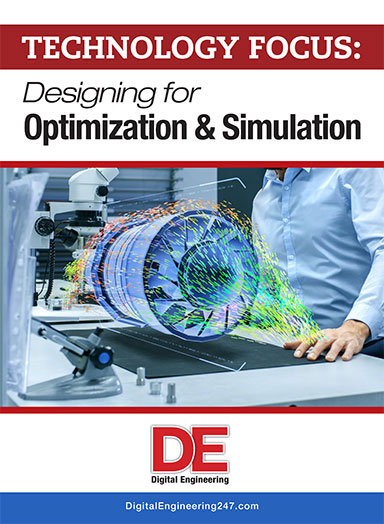The Modern Face of SPDM
As simulation-driven design becomes a core pillar of digital product development, a refreshed simulation product data management emerges.

ESTECO combines simulation process and data management capabilities with design optimization functionality in its VOLTA collaborative web platform. Image courtesy of ESTECO.
Latest News
November 19, 2020
As organizations continue to digitize product development processes, the growing and pervasive use of simulation highlights the need for a new generation of simulation product data management (SPDM) that is tightly woven into mainstream engineering fabric.
Although SPDM has been available for years, its highly specialized nature has led to limited adoption, primarily among pockets of simulation experts who use and maintain the platforms as silos, disconnected from common repositories of product-related data and outside of day-to-day engineering processes. More often than not, simulation data isn’t managed by a centralized platform like SPDM or even product lifecycle management (PLM). Rather, simulation data typically resides on individual engineers’ workstations, managed by spreadsheets or Microsoft Word documents, or sprinkled among the shared drives of specialized engineering groups.
Both scenarios make it difficult for stakeholders across the product lifecycle to find and access pertinent simulation data to drive better engineering decisions while complicating easy reuse of simulations to inform derivative design workflows or to improve upon existing product iterations.
With product complexity on the rise, driven in part by the Internet of Things (IoT) and the coupling of cyberphysical systems, the traditional paradigm of SPDM as a separate system is unsustainable, experts say.
The limitations of the early SPDM paradigm, combined with the growing emphasis on doing more, and more types of simulation as part of the ongoing digitization of the product development process, mean organizations need to re-evaluate a more formalized and modern SPDM incarnation.
“Siloed or simulation tool-specific SPDM is simply not scalable with the increasing demands for more and more simulation as part of the overall design process,” contends Pawel Chadzynski, senior director, product marketing at Aras. “When simulation data is in multiple spreadsheets owned by individual experts, you can’t scale up the volume of simulation needed for the complexity of products. You just can’t do it with existing infrastructure.”
Re-Envisioning SPDM
Although CIMdata doesn’t track SPDM offering sales, it is seeing an uptick in interest among companies as visibility of the category rises and as success stories trickle out, according to Don Tolle, practice director for simulation-driven systems development at the engineering consultancy and market research firm.
Advances in multiphysics simulation capabilities—the introduction of a greater number of modalities—along with more accessible and less expensive high-performance computing (HPC) resources are also fueling engineering organizations’ appetite for increased use of simulation throughout all stages of the design process.
“The size and complexity of [simulation] models are many orders of magnitude beyond what we were doing 10 years ago and we need to get a handle on that information and understand, not just the data, but the metadata,” says Tolle.
SPDM provides the means to add context to simulations, storing metadata that indicates who created simulations and why, what applications or product they were created for, and what assumptions were made when creating the model, he explains.
“If people are going to rely on digital models to make critical design decisions and not physically test everything, we have to have a high level of confidence in simulation results,” Tolle adds. “SPDM provides the technology and processes to put data governance around all the simulation work that’s being done.”

At Ansys, the vision for SPDM is a single purpose-built, domain-specific platform, yet the company does not believe simulation data and process management capabilities should be addressed as part of a broader PLM platform. Given the complexity of simulation data and the domain-specific nature of the workflows, Ansys believes an open, federated approach to SPDM is more effective than a single repository that owns the entirety of product-related data, including simulation models.
“We’re seeing a shift in mindset from the concept of a single source of truth and one monolithic environment to more of an authoritative source of truth,” says Sanjay Angadi, Ansys’ director of product management. “It’s a more realistic way of addressing transformation needs.”
To deliver a vendor-neutral and open approach to SPDM, Ansys turned to Aras and inked a deal to use the PLM vendor’s core PLM technology as the basis for its Minerva SPDM technology. Minerva, powered by Aras, uses Innovator’s core configuration management, access management and lifecycle services, while adding Ansys’ own capabilities in areas such as user interface, meta data extraction, HPC capabilities, and of course, simulation services.
“In this way, we aren’t reinventing the wheel for authentication or core configuration management,” Angadi explains. Aras’ open and interoperable philosophy also fits well with the Ansys approach, Angadi explains, as it allows the Minerva platform to co-exist with existing systems like product data management or enterprise resource planning as opposed to a rip-and-replace strategy that would lead to another landscape of siloed and isolated systems.
In addition, Ansys differentiates Minerva from other SPDM solutions through its user experience, which Angadi says is tuned for CAE users and workflows, in addition to its ability to integrate with a broad number of multiphysics simulation modules. Thanks to the open, federated nature of the platform, Minerva supports integration with Ansys Granta, which connects materials intelligence to simulation data and process workflows—another way Ansys is positioning its SPDM solution as a bridge as opposed to another island of information, Angadi adds.

Aras SPDM capabilities automatically associate simulation results with product requirements, closing the loop to ensure verification and validation. Image courtesy of Aras.
Aras also sees its core SPDM technology as a bridge to a broader universe of enterprise product-related data, including what’s already managed in Innovator PLM as part of the roadmap to creating a holistic digital thread.
Aras Simulation Management, based partly on its acquisition of the Comet vendor-neutral process automation technology, lets organizations connect simulation best practices and simulation data to the digital thread of product data managed by Innovator to provide full traceability and allow for repeatable use of simulation data across all stages of the design cycle.
Through automation and an easy-to-use interface, engineers can access available multiphysics capabilities, compare findings between different design variations and make simulation-driven design decisions based on the right version of the product and simulations.
The Aras Comet technology also allows engineering organizations to encapsulate and enforce modeling and simulation best practices across the product’s full lifecycle, which encourages repeatability. This means simulation data can be tapped for use cases that transcend engineering such as costing analysis, manufacturing or generative design disciplines.
“Simulation started off as tool-centered islands of information and then early SPDM tools helped with the communication between tool-specific islands, but they created another island unto themselves,” notes Malcolm Panthaki, Aras’ vice president, analysis solutions. “We ensure simulation data and processes are a natural and integral part of the overall digital thread across all stages of the lifecycle. In that way, the power of simulation data and processes can be more broadly leveraged by an organization.”
Automation, Easy Collaboration on the Horizon
Automation is another big piece of the vision for SPDM as the volume of simulations increases with more pervasive use of CAE throughout the design cycle. The rise of industrial Internet of Things and the digitization of manufacturing operations is giving way to increased use of simulation, which in turn demands more management capabilities, including automation.
“Within the next five years, you will run up against a wall if you don’t build out a data management environment because of design and manufacturing exploration,” says Michael Schlenkrich, product manager for SimManager at MSC Software. “But the data flow needs to be managed and orchestrated so everyone is sure they are doing simulation with the right data points and not accidentally capturing the wrong material properties or loads.”
Simcenter’s process automation capabilities span import and export capabilities, the ability to assemble selected component models into a file that gets submitted to an HPC cluster, as well as post-processing and reporting steps, saving engineers time and effort.
To deal with increasing data volumes and data heterogeneity, MSC’s SimManager also emphasizes a dynamic data model that manages simulation data and processes as objects, thus is tuned for constant change.
“The moment you customize or configure something in a static manner, you are dead,” Schlenkrich says. “SimManager maintains flexibility through the use of data objects, which allow customers to update and make revisions.”
ESTECO’s VOLTA system emphasizes a collaborative web environment to expand usage of engineering simulation data across teams and support design optimization. The platform allows teams to securely share simulation results and offers full transparency of simulations and metadata.
In addition, through tight coupling with ESTECO’s modeFRONTIER process automation platform, users can access the VOLTA Planner to perform optimization strategies through an automated design space that encourages exploration without having to deal with the complexity of process automation, according to Marco Turchetto, product manager for VOLTA.

Teamcenter’s zero install web client makes it easy for users to interact with simulation-specific data and workflows. Images courtesy of Siemens Digital Industries Software.
At Siemens Digital Industries Software, SPDM is addressed through TcSim, an add-on module to the Teamcenter PLM platform that supports end-to-end CAE simulation processes via an open system that can be integrated, through customization, with any CAE application. With its Teamcenter foundation, TcSim can address the security, scalability and multi-site performance requirements for SPDM on an enterprise scale while providing traceability across all functions, including design, manufacturing, test and simulation.
TcSim’s zero-install, cloud-ready client helps with ease of configuration and ensures access from anywhere—capabilities designed to address cultural challenges and further SPDM adoption.
“As the younger generation comes into the workforce, they’re used to accessing information on their mobile tablet or phones, and people are now working from home,” says Narendra Kondragunta, product manager of Teamcenter Simulation. “It’s critical that we provide a solution where information can be accessed from anywhere … and where simulation data is at your fingertips.” Moving forward, the collaborative nature of SPDM will be enhanced as vendors transition to the cloud and increase automation functionality. Machine learning and artificial intelligence capabilities will also play a larger role in driving more of that automation and in facilitating intelligent search functionality. In the end, it’s all about refining SPDM so it’s tailored to the way people want to work.
“Engineering is a team sport and teams are working together,” says CIMdata’s Tolle. “That’s a big change—it’s independent of SPDM, but it will have impact on the category.”
Beth Stackpole is a contributing editor to DE. You can reach her at beth@digitaleng.news.
More Ansys Coverage
More Aras Coverage
More CIMdata Coverage
More ESTECO Coverage
More Siemens Digital Industries Software Coverage
Subscribe to our FREE magazine, FREE email newsletters or both!
Latest News
About the Author
Beth Stackpole is a contributing editor to Digital Engineering. Send e-mail about this article to DE-Editors@digitaleng.news.
Follow DE





